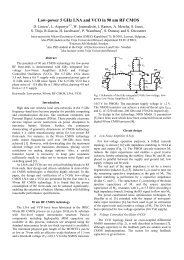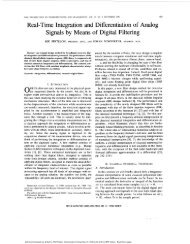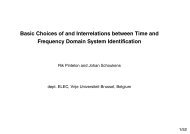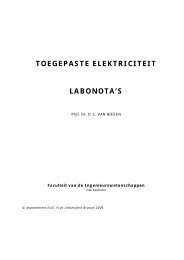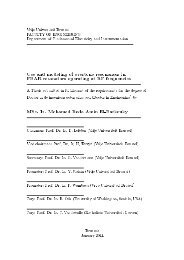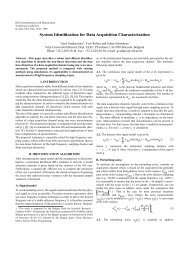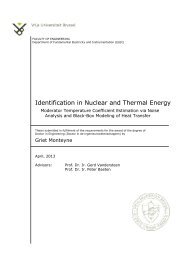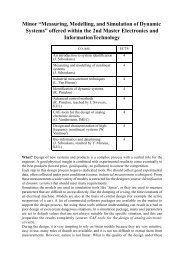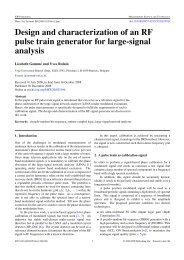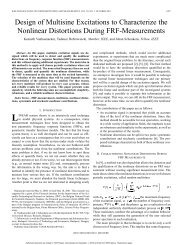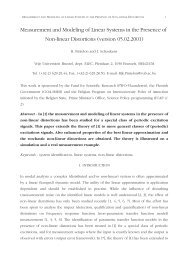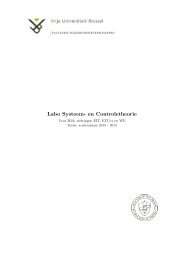Probability density function for frequency response function - Vrije ...
Probability density function for frequency response function - Vrije ...
Probability density function for frequency response function - Vrije ...
Create successful ePaper yourself
Turn your PDF publications into a flip-book with our unique Google optimized e-Paper software.
2where Uk () and Yk () are the input/output Discrete Fourier trans<strong>for</strong>m (DFT) spectra ofthe input/output samples u( nT s ) and ynT ( s ), n = 01… , , , N – 1 , with T s the samplingperiod. The measured input/output DFT spectra U(), k Yk () are related to the truevalues U 0 (), k Y 0 () k byYk () = Y 0 () k + N Y () kUk () = U 0 () k + N U () k(2)with Y 0 () k = G 0 ( jω k )U 0 () k and N U (), k N Y () k the disturbing input/output errors. Notethat the input/output errors in (2) may be correlated due to generator noise, and/orprocess noise in feedback, and/or common disturbances picked up by both acquisitionchannels of the measurement device [3].In [3] the expected value of the FRF estimate (1) has been calculated <strong>for</strong> the generalcase of correlated input/output errors N U (), k N Y (). k It has also been shown in [3] thatthe variance of (1) is infinitely large, but that it is still possible to construct confidenceregions with a given confidence level <strong>for</strong> Ĝ( jω k ). These confidence regions are validonly if the input signal-to-noise (SNR) ratio is larger than or equal to 20 dB . Note thatinput SNRs lower than 20 dB are typically encountered at the resonance <strong>frequency</strong> oflightly damped vibrating mechanical structures. The main contribution of this paper isto calculate exact confidence regions <strong>for</strong> Ĝ( jω k ) which are valid FOR ANY input SNR.These confidence bounds are calculated via an analytic expression of the probability<strong>density</strong> <strong>function</strong> (pdf) of Ĝ( jω k ). Using the pdf of Ĝ( jω k ) it is also possible to verify<strong>for</strong> which input SNR the FRF Ĝ( jω k ) is circular complex normally distributed.Summarized, the contributions of the paper are: (i) calculation of the exact pdf of (1);(ii) calculation of confidence regions <strong>for</strong> (1) <strong>for</strong> any input/output SNR; (iii) verification<strong>for</strong> which input SNR (1) is circular complex normally distributed; (iv) illustration of thetheory on a real measurement example. Note that the results are valid <strong>for</strong> open- andclosed-loop FRF measurements.II. PROBABILITY DENSITY FUNCTION FRF ESTIMATEA. Main resultThe probability <strong>density</strong> <strong>function</strong> (pdf) of the FRF estimate (1) is calculated, assumingthat the input/output errors N Z () k = [ N Y () k N U () k ] T of the DFT spectra (2) are zeromean, jointly correlated, circular complex normally distributed random variables (tosimplify the notations the <strong>frequency</strong> index k is dropped)
5normally distributed (the equi-pdf lines are not ellipses with centre E{ Ĝ} ), while <strong>for</strong>SNR U = 40 dB (7) seems to be indistinguishable from a circular complex normaldistribution (the equi-pdf lines are circles with centre E{ Ĝ} ). To quantify moreprecisely how close (7) matches a circular complex normal pdf, (7) is approximated inleast squares sense byin a disc with centre E{ z} and radius rf n () z = exp( – z – µ 2 0 ⁄ σ20 ) ⁄ ( πσ20 )(14)E{ z} = 1–exp( – 1 ⁄ σ2u )( 1 – ρσ y ⁄ σ u )r = σ 1 – ln( 1 – p)(15)σ2 1 = σ2 y + σ2 u – 2σ u σ y Re( ρ)(see [3] <strong>for</strong> the calculation of E{ z} ). The value of p ∈ [ 01 , ] corresponds to the p %confidence level of the disc with centre E{ z} and radius r <strong>for</strong> the pdfexp( – z – E{ z} 2 ⁄ σ21 ) ⁄ ( πσ21 )(16)Since f z () z converges <strong>for</strong> σ u → 0 to (16) (see [3]), E{ z} and σ2 1 are used as startingvalues <strong>for</strong> µ 0 and σ 02 in the nonlinear minimization problem. The approximation error<strong>for</strong> the bottom left pdf of Figure 2 is shown in Figure 3. Table 1 gives the upper boundon the approximation error as a <strong>function</strong> of the input SNR, SNR U , and the radius of thedisc r (the results are valid <strong>for</strong> any σ y and ρ ). Taking into account (i) the dynamicrange of the pdf (16) <strong>for</strong> the different radii r (see Table 1), and (ii) the fact that theworst case approximation error occurs at the border of the disc (see Figure 3), it followsfrom Table 1 that in the neighborhood of the expected value E{ z} , (7) can beapproximated very well by a circular complex normal distribution (14) <strong>for</strong>SNR U≥ 40 dB .D. Circular complex approximationA random variable is circular complex distributed ifE{ ( z –E{ z} ) 2 } = 0 and E{ z – E{ z} 2 } < ∞(17)The difficulty here is that the second order moments of z (6) do not exist. There<strong>for</strong>e, asis done in practise when calculating the sample variance of FRF measurements [7], theoutliers in z (6) are removed. Outliers are, <strong>for</strong> example, those values of z such thatz – E{ z} > r with Prob( z – E{ z} ≤ r) = 0.9999 (see Appendix D <strong>for</strong> the calculation ofr ). The second order moments of the truncated variable z (= z without outliers) exist,and the ratio
6γσ ( y , σ u , ρ)E{ ( z –E{ z} ) 2 }= -----------------------------------E{ z – E{ z} 2 =}∫( z –E{ z} ) 2 f z () z dzz– E{ z} ≤ r-----------------------------------------------------------------------z – E{ z} 2 , (18)∫f z () z dzz – E{ z} ≤ ris then a measure of how well z is circular complex distributed. Note that E{ z} in (18)can be approximated very well by E{ z} (15). Numerical calculation of (18) over adense grid of ρ - and σ y -values, with ρ ≤ 1 and σ y ≥ 1 , shows that the ratioγσ ( y , σ u , ρ) is maximal <strong>for</strong> ρ = – 1 , and that the maximal value γ max is independent ofσ y . Note that the fact that γ is maximal <strong>for</strong> ρ = – 1 is consistent with the observationthat the pdf (7) has the largest asymmetry <strong>for</strong> ρ = – 1 (see Figure 2). Figure 4 showsγ max as a <strong>function</strong> of the input signal-to-noise ratio. It follows that the truncatedvariable z can be approximated very well by a circular complex distributed randomvariable <strong>for</strong> SNR U≥ 20 dB .Via a perturbation analysis of (4)III. CONFIDENCE REGIONS OF THE FRF ESTIMATEĜ( jω k ) ≈ G 0 ()1 k ( + yk ()–uk ())(19)circular p % confidence regions with center E{ Ĝ} and radius R = r G 0 wereconstructed in [3]Prob( Ĝ – E{ Ĝ} ≤ R) = Prob( z – E{ z} ≤ r) = p(20)with E{ z} and r defined in (15), and where the probability Prob( ) is calculated using(16). Eq. (20) is accurate only if the input SNR is larger than 20 dB (see [3]). The exactconfidence level of the circular confidence region Ĝ – E{ Ĝ} ≤ R is calculated throughnumerical integration of2π rProb( z – E{ z} ≤ r) =∫ ∫f z ( E{ z} + r 1 e jθ )r 1 dr 1 dθ(21)0 0with f z () z defined in (7). Figure 5 compares the calculated confidence level (21) to the5one obtained from 5×10 FRF estimates Ĝ( jω k ) (1). It follows that both coincide.Note that (20) and (21) define an equation of the <strong>for</strong>mgr () = p(22)where gr () is a monotonic increasing <strong>function</strong> of r . Hence, (22) has exactly onesolution r = g – 1 () p , which can be calculated using an iterative root finding algorithm(see Appendix D). Solving (22) <strong>for</strong> r allows to draw uncertainty bounds with a givenconfidence level <strong>for</strong> FRF measurements Ĝ . Figure 6 compares the true value of r(solution (22)) with the value (15) predicted by the Gaussian approximation (16), <strong>for</strong>three different values of the confidence level p . For large input SNRs (SNR U≥ 20 dB )
7both radii coincide <strong>for</strong> any p . For small input SNRs and p = 0.95 the true solution islarger than the Gaussian approximation (15), while the reverse is true <strong>for</strong> p = 0.50 .These observations are consistent with the results of Figure 5: <strong>for</strong> p = 0.95 the truefraction outside the p % confidence region is larger than that predicted by the Gaussianapproximation, while the converse is true <strong>for</strong> p = 0.50 . Note also that the differencebetween the true solution and the Gaussian approximation becomes very large <strong>for</strong>confidence levels close to one. This is explained by the fact that the Gaussianapproximation (16) decreases exponentially while (7) decreases as 1 ⁄ z 4 <strong>for</strong> zsufficiently large.IV. MEASUREMENT EXAMPLEAn iron beam (length 39.4 cm, width 2.4 cm, thickness 0.4 cm, and weight 354 g) isexcited in its point of gravity by a mini shaker (B&K 4810). The <strong>for</strong>ce applied to thebeam and the acceleration of the beam are measured with an impedance head (B&K8001). The <strong>for</strong>ce and acceleration signals of the impedance head are amplified (chargeamplifier B&K 2635) and buffered (buffers with a 50 Ω output impedance) be<strong>for</strong>e beingapplied to the acquisition unit (HP E1437A). An arbitrary wave<strong>for</strong>m generator (HPE1445A) creates the excitation current of the mini shaker.The beam is excited with a multisine consisting of F = 556 frequencies equallydistributed in the band [ 1.2 kHz,2.6 kHz] . The multisine has a random phase spectrum(uni<strong>for</strong>mly distributed in [0, 2π)) and a flat amplitude spectrum (the RMS value of themeasured acceleration is 36.6 mV). Four hundred consecutive periods of the steadystate <strong>response</strong> are measured at the sampling <strong>frequency</strong> f s = 20 MHz ⁄ 2 11 , which gives400 × 4096 data points per measured signal. From the M = 400 sets of F input/outputFourier coefficients, U[ m ]k , Y [ m]k with m = 12… , , , M and k = 12… , , , F , one cancalculate the <strong>for</strong>ce over acceleration <strong>frequency</strong> <strong>response</strong> <strong>function</strong> (see Figure 7)Ĝ( jω k )1Ŷ k M---- MY [ m ]∑m = 1 k = ----- = ------------------------------------ , (23)Û1 kM---- MU [ m ]∑m = 1 kthe input/output SNRs corresponding to one measured period (see Figure 8.a and 8.b),and the correlation coefficient (see Figure 8.c)SNR U () kÛ= ------------- k, SNRσˆ U () k Y () kŶ= ------------ k, ρσˆ Y () kσˆ 2YU () k=σˆ --------------------------exp (–Y ()σˆ k U () kj ∠ Ĝ ( jω ))(24)kwith σˆ (), k σˆ () k and σˆ 2 U2 Y2 YU () k the sample (co-)variances
8σˆ () k U2σˆ () k Y2σˆ 2YU () k1M ------------- M– 1U [ m ] 2= ∑ – Û k km = 11M ------------- M– 1Y [ m ] 2= ∑ – Ŷ k km = 11 M= ------------- ( Y[ m] M – 1k – Ŷ k ) U[ m] ∑( k – Û k )m = 1(25)Note that the input and output SNRs are minimal at, respectively, the resonance (1.7kHz) and anti-resonance (2.1 kHz) <strong>frequency</strong> of the FRF, and that the input/outputdisturbances are highly correlated around 1.95 kHz (see Figure 8.c).From the M = 400 sets of F = 556 FRF residualsG [ m]( jω k )1M---- M– ∑ G[ m]( jω k ) with G [ m]( jωm = 1k ) = Y [ m ] U [ m ]k ⁄(26)kone can calculate any p % percentile. It allows to verify experimentally the exact p %confidence bound (22). Since the difference between the exact (22) and the Gaussian(15) confidence bounds is apparent <strong>for</strong> low input SNRs (see Figure 5) and largeconfidence levels (see Figure 6) only, the p = 99% confidence bounds are comparedin the neighborhood of the resonance <strong>frequency</strong> of the FRF. The results are shown inFigure 9.a. It follows that the p = 99% percentile of the FRF residuals (26) and theexact p = 99% confidence bound coincide, while a significant difference with theGaussian approximation can be observed <strong>for</strong> low input SNRs (SNR U < 10 dB ). Thefraction of the residuals (26) outside the exact and the Gaussian p = 99% confidencebounds is shown in Figure 9.b. Note the good fraction prediction of the exact bound(mean value fraction = 0.997%) and the large deviation of the Gaussian approximation(mean fraction = 3.98%).V. CONCLUSIONBased on an analytic expression <strong>for</strong> the pdf of FRF measurements, exact uncertaintybounds <strong>for</strong> FRF measurements have been derived. For input SNRs larger than 40 dB thepdf can be approximated very well by a circular complex normal pdf. For input SNRslarger than 20 dB the uncertainty bounds (fraction, uncertainty levels, …) of the FRFand the second order moments of the truncated FRF (= FRF without outliers) arepredicted very well by the Gaussian approximation (16). The obtained results wereverified using real world measurements.APPENDIX APROOF OF THE THEOREMThe calculation the pdf of z = ( 1 + y) ⁄ ( 1 + u)(6), is facilitated by introducing anauxiliary variable v = u (see [5], Chapter 7). The joint pdf f zv ( zv , ) of z and v is
9related to the joint pdf f yu ( yu , ) of y and u byf zv ( zv , ) = f yu ( z( 1 + v) – 1,v) J(27)with J the determinant of the Jacobian of the trans<strong>for</strong>mation from( Re()Im z , ()Re z , ()Im v , () v ) to ( Re()Im y , ()Re y , ()Im u , () u ) (see [5]). Using∂y⁄ ∂Re()z = 1 + v , ∂y⁄ ∂Im()z = j( 1 + v), ∂y⁄ ∂Re()v = z , ∂y⁄ ∂Im()v = jz ,Re( j( 1 + v)) = – Im( 1 + v), and Im( j( 1 + v)) = Re( 1 + v), we findJ= ∂( ---------------------------------------------------------------------- Re()Im y , ()Re y , ()Im u , () u ) =∂( Re()Im z , ()Re z , ()Im v , () v )1 + v 2(28)The pdf of z is found by integrating the joint pdf f zv ( zv , ) (27) over v+∞ +∞f z () z = f zv ( zv , ) 1 + v 2 dRe()v dIm()v(29)∫∫–∞ –∞Since y = N Y ⁄ Y 0 and u = N U ⁄ U 0 are by assumption (3) circular complex normallydistributed, we havewheref yu ( z( 1 + v) – 1,v)HC 1– z( 1 + v) – 1 – z( 1 + v)– 11vv= ---------------------eπ 2 (30)det( C)Cσ 2y σ2= yu(31)σ 2 yu σ2uCollecting (27) to (31) gives, after some calculations,f z () zσ2+∞ +∞= ------------------e v – z – 1 2 ⁄ az () fπdet( C)∫ ∫ v ()1 v + v 2 dRe()v dIm()v(32)–∞ –∞where f v () v is the pdf of a circular complex normally distributed random variable vwith mean µ v and variance σ2vf v () v1 –---------e v – µ v2 ⁄ σ2bz ()= v , µπσ2v = -------- , σ2 det( C)az () v = --------------(33)az ()vand where a(), z b() z are defined in (8). Note that the double integral in (32) is nothingelse than E{ 1 + v 2 } . Collecting E{ 1 + v 2 } = σ2 v + µ v + 1 2 , (32), and (33) gives (7).Let yAPPENDIX BPROOF OF EQ. (9)= ax with y , x complex random variables and a a complex number. The pdf
10f y () yof y is related to the pdf f x () x of x by f y () y = f x ( y⁄a) J with J thedeterminant of the Jacobian of the trans<strong>for</strong>mation from ( Re()Im y , () y ) to ( Re()Im x , () x )(see [5]). Using∂xIm( j⁄a) = Re( 1 ⁄ a)we find⁄ ∂Re()y = 1 ⁄ a , ∂x⁄ ∂Im()y = j⁄a , Re( j⁄a) = – Im( 1 ⁄ a), andwhich concludes the proof.J∂Re()x ∂Re()x--------------- --------------- Re( 1 ∂Re()y ∂Im()y ā - ) Re( j ā - )= =∂Im()x ∂Im()x--------------- --------------- Im( 1 ∂Re()y ∂Im()y ā - ) Im( j =ā - )1-------a 2(34)APPENDIX CPROOF OF EQ. (13)For the closed-loop measurement set up shown in Figure 1, (2) becomesRGU 0 = ---------------------- Y 0 RN1 + G 0 C 0 = ---------------------- N P C 0N, ,0 1 + G 0 C U = –---------------------- , N P0 1 + G 0 C Y = ---------------------- (35)0 1 + G 0 C 0Hence, u = – N P C 0 ⁄ R , y = N P ⁄ ( G 0 R), andσσ22 P C 20 σ2u = -------------------R 2 σ2P Cy = ----------------G 0 R 2 ρ -------- G 0 0, , = – ---------(36)C 0 G 0Collecting (9), (12), (36) andgives (13).2σ 2= var( Y⁄R)=Ĝ – G----------------------------------------------------- 0=( 1 + ĜC 0 )( 1 + G 0 C 0 )σ2-------------------------------------- PR 2 1 + G 0 C 20Ĝ G-------------------- – ---------------------- 01 + ĜC1 + G 0 C 00(37)APPENDIX DROOT FINDING ALGORITHM FOR (22)The i th step of the iterative Newton-Raphson root finding algorithm <strong>for</strong> (22) isr ( i + 1)= r () i – ( gr ( () i )–p) ⁄ g' ( r () i )(38)with g' () r the derivative of g() r w.r.t. r (see [8]). The Gaussian approximation (15) istaken as starting value, r ( 0)= σ 1 – ln( 1 – p), and the <strong>function</strong>s g(), r g' (), r2π rgr () f z ( E{ z} + r 1 e jθ2π=∫ ∫)r 1 dr 1 dθ, g' () r = r f z ( E{ z} + re jθ ) dθ0 0∫(39)0with f z () z and E{ z} defined in (7) and (15) respectively, are calculated via numerical
11integration (see, <strong>for</strong> example, [8]).REFERENCES[1] K. Godfrey (ed.), Perturbation Signals <strong>for</strong> System Identification, Prentice Hall,Hempstead (UK), 1993.[2] R. Pintelon and J. Schoukens, System Identification: A Frequency Domain Approach,IEEE Press, Piscataway (USA), 2001.[3] R. Pintelon and J. Schoukens, “Measurement of <strong>frequency</strong> <strong>response</strong> <strong>function</strong>s usingperiodic excitations, corrupted by correlated input/output errors,” IEEE Trans.Instrum. Meas., vol. 50, no. 6, pp. ?-?, 2001.[4] D. R. Brillinger, Time Series: Data Analysis and Theory, McGraw-Hill, New York,1981.[5] A. Papoulis, <strong>Probability</strong>, Random Variables, and Stochastic Processes. McGraw-Hill,New York, 1981.[6] W. P. Heath, “<strong>Probability</strong> <strong>density</strong> <strong>function</strong> of indirect non-parametric transfer<strong>function</strong> estimates <strong>for</strong> plants in closed loop,” Preprints of the 12th IFAC Symposiumon System Identification, Santa Barbara (USA), June 21-23, 2000.[7] Guillaume P., I. Kollar and R. Pintelon (1996). Statistical analysis of nonparametrictransfer <strong>function</strong> estimates, IEEE Trans. Instrum. Meas., vol. IM-45, no. 2, pp. 594-600.[8] A. Ralston and P. Rabinowitz, A First Course in Numerical Analysis, McGraw-Hill,New York (USA), 1984.
12Figure and Table captionsFigure 1: Frequency <strong>response</strong> <strong>function</strong> (FRF) measurement in closed-loop. G 0 and C 0are the true device under test and controller FRFs respectively, R is the referencesignal, N P is the process noise, and the input U and noisy output Y are observedwithout measurement errors.Figure 2: <strong>Probability</strong> <strong>density</strong> <strong>function</strong> (pdf) of z = ( 1 + y) ⁄ ( 1 + u)(eq. (7)) in decibels<strong>for</strong> σ y = 1 (SNR Y = 0 dB ) and ρ = – 1 . Top figures: σ u = 0.4 (SNR U = 8 dB ),bottom figures: σ u = 0.01 (SNR U = 40 dB ), left figures: pdfs, right figures: equi-pdflines (contour plot pdfs). The ‘+’ symbol in the contour plots indicates the expectedvalue of z .Figure 3: Difference between the true pdf f z () z (7) in dB and the Gaussianapproximation f n () z (14) in dB <strong>for</strong> σ y = 1 (SNR Y = 0 dB ), ρ = – 1 , and σ u = 0.01(SNR U = 40 dB ). The true pdf is shown in Figure 2 (bottom left figure).Figure 4: Maximum over σ y and ρ of the ratio γ( σ y , σ u , ρ) (18) as a <strong>function</strong> of theinput signal-to-noise ratio SNR U = 1 ⁄ σ u .Figure 5: Fraction of Ĝ outside the confidence region Ĝ – E{ Ĝ} ≤ rG 0 with radius r(15) and σ y = 1 as a <strong>function</strong> of the input signal-to-noise ratio SNR U : p = 50% (1),p = 60% (2), p = 70% (3), p = 80% (4), p = 90% (5), and p = 95% (6). Solid5lines: fractions calculated via eq. (21), symbols +: fractions calculated using 5×10 FRFestimates Ĝ (eq. (1)). (a) ρ = – 1 , (b) ρ = 0 , and (c) ρ = 0.5exp( jπ ⁄ 8).Figure 6: Radius r of the circular confidence region <strong>for</strong> z (6) as a <strong>function</strong> of the inputsignal-to-noise ratio SNR U , with σ y = 1 , and p = 50% (I), p = 95% (II) andp = 99% (III). Solid line: true value of r (solution of (22)); and dashed line: value of r(15) predicted by the Gaussian approximation (16). (a) ρ = – 1 , (b) ρ = 0 , and (c)ρ = 0.5exp( jπ ⁄ 8).Figure 7: Magnitude (a) and phase (b) of the FRF (<strong>for</strong>ce/acceleration) of the iron beam.Figure 8: Uncertainty of the FRF measurement. (a) input SNR, (b) output SNR, and (c)magnitude of the correlation coefficient.Figure 9: Analysis of the FRF residuals (26) in the neighborhood of the resonance<strong>frequency</strong>. (a) Comparison of the p = 99% percentile (+) of the residuals, with theexact (black line) and the Gaussian (gray line) p = 99% uncertainty bounds. (b)Fraction of the residuals outside the exact (black line) and the Gaussian (gray line)p = 99% confidence bound.Table 1: Upper bound on the difference between f z () z (7) in dB and f n () z (14) in dB
13as a <strong>function</strong> of the input signal-to-noise ratio SNR U and the radius r (15). The 4 radiicorrespond to a dynamic range of the pdf (16) of 78 dB, 26 dB, 9.9 dB, and 6 dBrespectively. The corresponding p % confidence level is that of the normal pdf (16).
14Figure 1: Frequency <strong>response</strong> <strong>function</strong> (FRF) measurement in closed-loop. G 0 and C 0are the true device under test and controller FRFs respectively, R is the referencesignal, N P is the process noise, and the input U and noisy output Y are observedwithout measurement errors.controllerC 0 ( jω)N PR+-Udeviceunder testG 0 ( jω)Y
15Figure 2: <strong>Probability</strong> <strong>density</strong> <strong>function</strong> (pdf) of z = ( 1 + y) ⁄ ( 1 + u)(eq. (7)) in decibels<strong>for</strong> σ y = 1 (SNR Y = 0 dB ) and ρ = – 1 . Top figures: σ u = 0.4 (SNR U = 8 dB ),bottom figures: σ u = 0.01 (SNR U = 40 dB ), left figures: pdfs, right figures: equi-pdflines (contour plot pdfs). The ‘+’ symbol in the contour plots indicates the expectedvalue of z .pdf z = (1+y)/(1+u)2SNR U=8 dB0-50-100-150-200-25020imag(z)-2-20real(z)24imag(z)1.510.50-0.5-1-1.5-2-1 0 1 2 3real(z)pdf z = (1+y)/(1+u)21.5SNR U = 40 dB0-20-40-60-80-10020imag(z)-2-20real(z)24imag(z)10.50-0.5-1-1.5-2-1 0 1 2 3real(z)
16Figure 3: Difference between the true pdf f z () z (7) in dB and the Gaussianapproximation f n () z (14) in dB <strong>for</strong> σ y = 1 (SNR Y = 0 dB ), ρ = – 1 , and σ u = 0.01(SNR U= 40 dB ). The true pdf is shown in Figure 2 (bottom left figure).pdf z = (1+y)/(1+u)db210-1-220imag(z)-2-20real(z)24
17Figure 4: Maximum over σ y and ρ of the ratio γ( σ y , σ u , ρ) (18) as a <strong>function</strong> of theinput signal-to-noise ratio SNR U= 1 ⁄ σ u .-20maximal ratio (dB)-30-40-50-60-700 5 10 15 20 25SNR U (dB)
18Figure 5: Fraction of Ĝ outside the confidence region Ĝ – E{ Ĝ} ≤ rG 0 with radius r(15) and σ y = 1 as a <strong>function</strong> of the input signal-to-noise ratio SNR U : p = 50% (1),p = 60% (2), p = 70% (3), p = 80% (4), p = 90% (5), and p = 95% (6). Solid5lines: fractions calculated via eq. (21), symbols +: fractions calculated using 5×10 FRFestimates Ĝ (eq. (1)). (a) ρ = – 1 , (b) ρ = 0 , and (c) ρ = 0.5exp( jπ ⁄ 8).fraction% outside p% conf. region fraction% outside p% conf. region fraction% outside p% conf. region50D D D D D D 50D DD D D D D D D 50D D D D DD(1)D(1)D D DDD(1)DD40D D D D D D D D 40 DD DDD D D D D D 40D D D D D D D(2)D(2)DD(2)D DD DD D30 D D DDD D D D D D 30D D D D D DDDDD 30D DD D D D D D D D(3) D D(3)D(3)DD DDD20D DDDDDDDDD DDD D DD D D20D D D 20D D D D D DD(4) D(4) DD(4)DDDDD DDD D DD DDDDD D10DDDD DD D D D D D10DD DDDD D D D D D10DDD D D DD D(5)DD D DD(5)DD DD DD(5)D D DD D D D D(6)(6)(6)0000 5 10 15 20 25 0 5 10 15 20 25 0 5 10 15 20 25SNR U (dB)SNR U (dB)SNR U (dB)(a) (b) (c)
19Figure 6: Radius r of the circular confidence region <strong>for</strong> z (6) as a <strong>function</strong> of the inputsignal-to-noise ratio SNR U , with σ y = 1 , and p = 50% (I), p = 95% (II) andp = 99% (III). Solid line: true value of r (solution of (22)); and dashed line: value of r(15) predicted by the Gaussian approximation (16). (a) ρ = – 1 , (b) ρ = 0 , and (c)ρ = 0.5exp( jπ ⁄ 8).12radius p% confidence region(III)12radius p% confidence region12radius p% confidence region8(II)8(III)8(III)44(II)4(II)(I)00 5 10 15 20 25SNR U (dB)(I)00 5 10 15 20 25SNR U (dB)(I)00 5 10 15 20 25SNR U (dB)(a) (b) (c)
20Figure 7: Magnitude (a) and phase (b) of the FRF (<strong>for</strong>ce/acceleration) of the iron beam.40200Amplitude (dB)200-20Phase (°)1000-100-401000 1500 2000 2500 3000f (Hz)(a)-2001000 1500 2000 2500 3000f (Hz)(b)
23Table 1: Upper bound on the difference between f z () z (7) in dB and f n () z (14) in dBas a <strong>function</strong> of the input signal-to-noise ratio SNR U and the radius r (15). The 4 radiicorrespond to a dynamic range of the pdf (16) of 78 dB, 26 dB, 9.9 dB, and 6 dBrespectively. The corresponding p % confidence level is that of the normal pdf (16).max f z () z – f n () zdB dBr(p %)3σ 1(99.988% )1.73σ 1(95% )1.07σ 1(68% )0.83σ 1(50% )20 dB 20 5 1 0.5SNR U (dB)40 dB 2 0.5 0.1 0.0560 dB 0.2 0.05 0.01 0.00580 dB 0.02 0.005 0.001 0.0005



